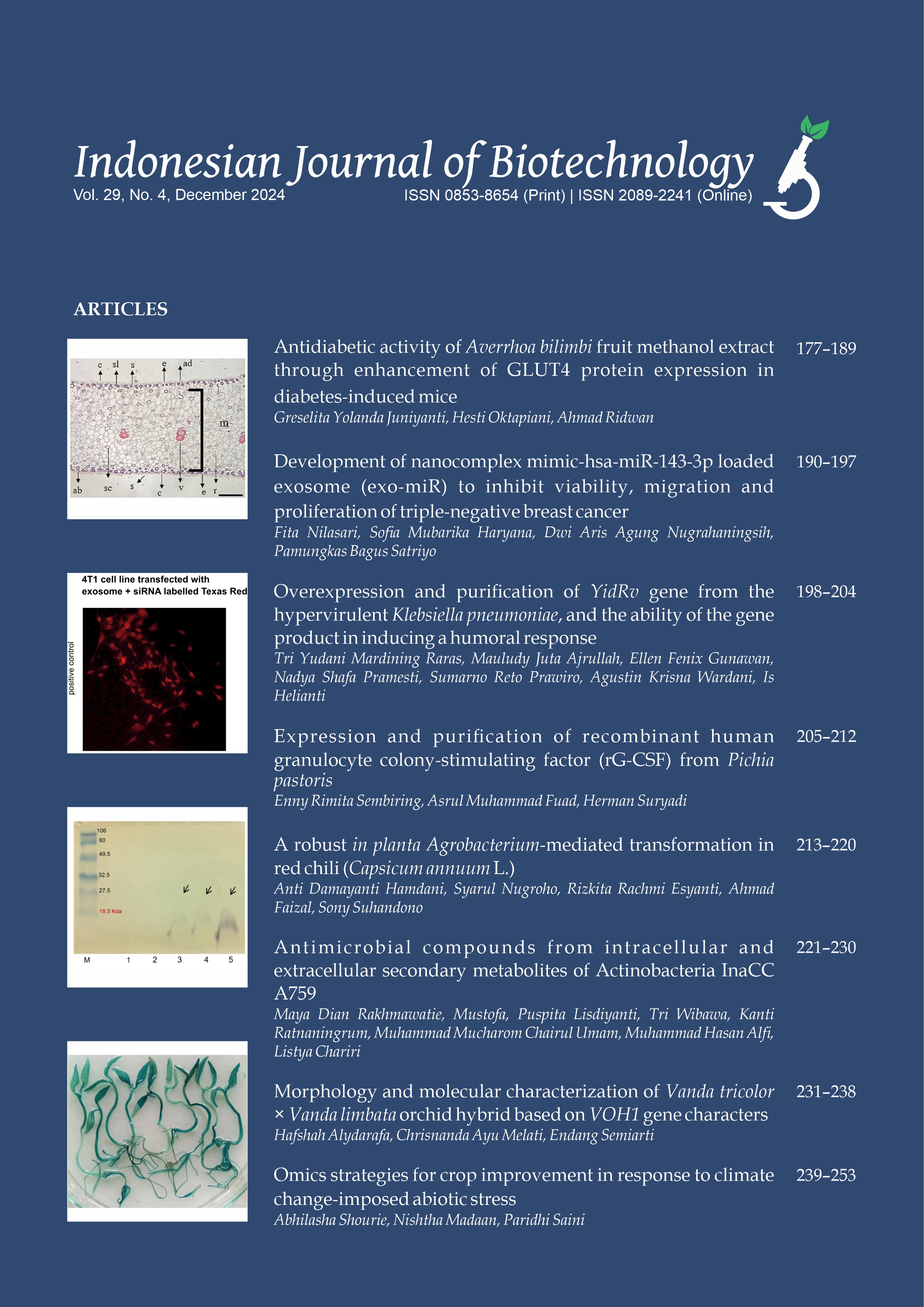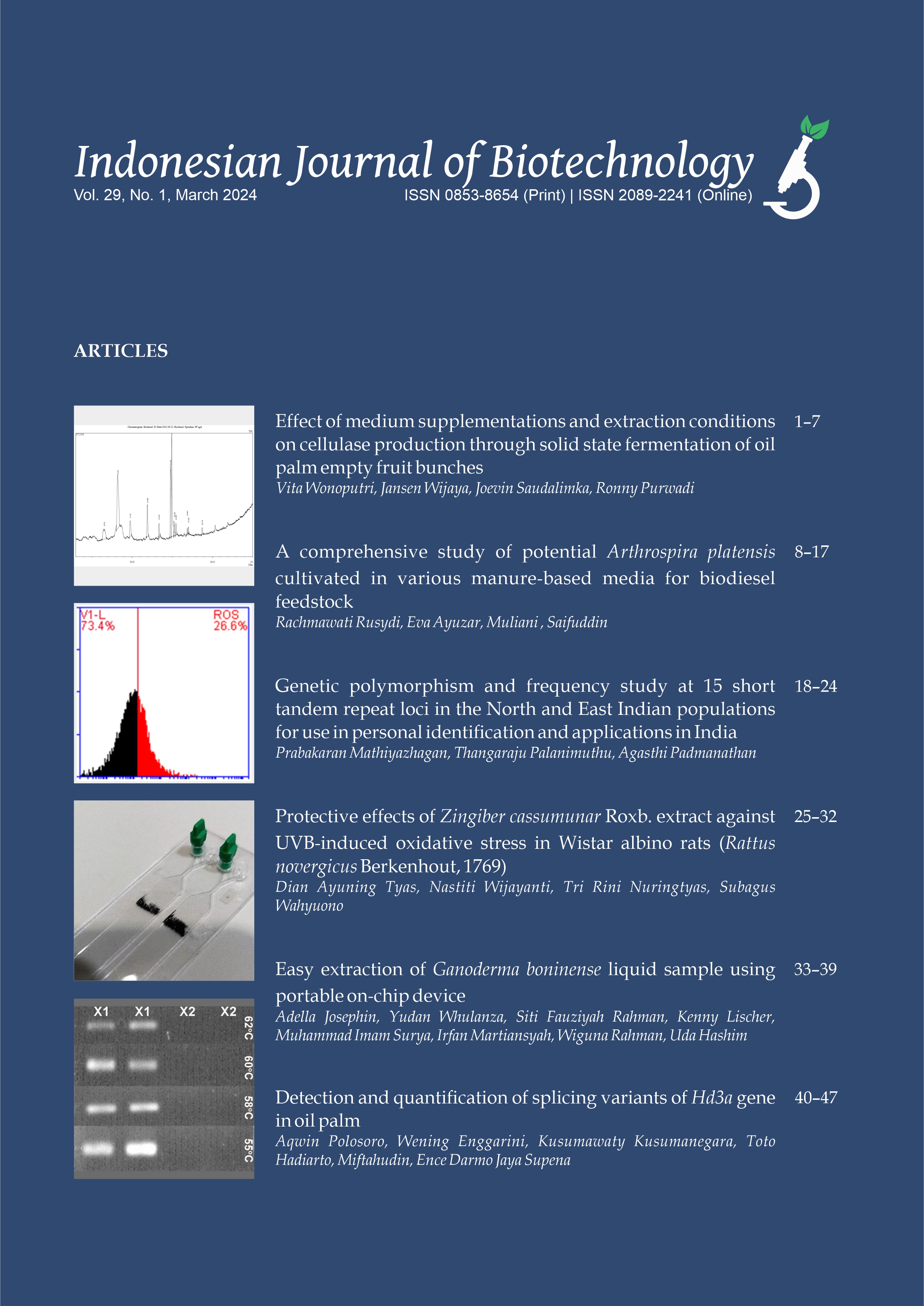The diversity of fungal associates of Dendrobium ovatum (L.) Kraenzl., an endemic orchid of the Western Ghats of India
Reedhu Raj(1), Joseph Job(2), Prasanna Rajan(3), Sijo Mathew(4), Rasmi Avanoor Ramanathan(5), Elizabeth Cherian(6*)
(1) Department of Botany, Government Victoria College, Palakkad (University of Calicut), Kerala, India
(2) Department of Botany, St. Berchmans College, Changanassery, (Mahatma Gandhi University, Kottayam), Kerala, India
(3) Department of Botany, Government College Kottayam, (Mahatma Gandhi University, Kottayam), Kerala, India
(4) Department of Botany, Government College Kottayam, (Mahatma Gandhi University, Kottayam), Kerala, India
(5) Department of Botany, Government Victoria College, Palakkad (University of Calicut), Kerala, India
(6) Department of Botany, CMS College Kottayam (Mahatma Gandhi University, Kottayam), Kerala, India
(*) Corresponding Author
Abstract
Dendrobium ovatum is a tropical epiphytic orchid endemic to the Western Ghats of India and has been listed as a threatened species in recent research due to its declining populations and changes in flowering and fruit set patterns. This study aims to investigate the mycoflora associated with the roots, stems and leaves of D. ovatum. Both surface‐associated and endophytic fungal associates were isolated and identified using morphological and molecular methods. The study resulted in the isolation of 139 cultures, which were divided into 24 morphotypes, 99% of which belonged to Ascomycota. The most dominant members, Trichoderma harzianum and Colletotrichum gloeosporioides, were consistently observed across all the study sites. Tissue‐specific fungal diversity analysis revealed that each organ was dominated by a distinct fungal group, forming characteristic communities specific to each tissue. The roots of D. ovatum exhibited the highest species richness and diversity, compared to the stem and leaves. This research also represents the first documentation of fungal associates of the threatened orchid D. ovatum.
Keywords
References
Abdusattorova NU, Narmuhamedova MK, Xusanov TS. 2024. Isolation and identification of endophytic microorganisms from Silibium marianum plant. Sci. Innov. 3(3):24–28. doi:10.5281/zenodo.10783105.
Adit A, Koul M, Kapoor R, Tandon R. 2022. Topological analysis of orchidfungal endophyte interaction shows lack of phylogenetic preference. South African J. Bot. 149:339–346. doi:10.1016/j.sajb.2022.06.025.
Alomía YA, Otero JT, Jersáková J, Stevenson PR. 2022. Cultivable fungal community associated with the tropical orchid Dichaea andina. Fungal Ecol. 57 58:101158. doi:10.1016/j.funeco.2022.101158.
Amend A. 2014. From dandruff to deepsea vents: Malassezialike fungi are ecologically hyperdiverse. PLoS Pathog. 10(8):e1004277. doi:10.1371/journal.ppat.1004277.
Carroll G. 1988. Fungal endophytes in stems and leaves: from latent pathogen to mutualistic symbiont. Ecology 69(1):2–9. doi:10.2307/1943154.
Chand K, Shah S, Sharma J, Paudel MR, Pant B. 2020. Isolation, characterization, and plant growthpromoting activities of endophytic fungi from a wild orchid Vanda cristata. Plant Signal. Behav. 15(5):1744294. doi:10.1080/15592324.2020.1744294.
da Silva LL, Moreno HLA, Correia HLN, Santana MF, de Queiroz MV. 2020. Colletotrichum: species complexes, lifestyle, and peculiarities of some sources of genetic variability. Appl. Microbiol. Biotechnol. 104(5):1891–1904. doi:10.1007/s0025302010363 y.
Dastogeer KM, Tumpa FH, Sultana A, Akter MA, Chakraborty A. 2020. Plant microbiome–an account of the factors that shape community composition and diversity. Curr. Plant Biol. 23:100161. doi:10.1016/j.cpb.2020.100161.
De Mers M. 2022. Alternaria alternata as endophyte and pathogen. Microbiol. (United Kingdom) 168(3):001153. doi:10.1099/mic.0.001153.
Deepthi AS, Ray JG. 2021. Ecological relevance of the endophytic fungal diversity in velamen roots of tropical epiphytic orchids. Czech Mycol. 73(1):91–108. doi:10.33585/CMY.73107.
Fay MF. 2018. Orchid conservation: how can we meet the challenges in the twentyfirst century? Bot. Stud. 59:16. doi:10.1186/s405290180232z.
Félix CR, da Silva Nascimento BE, Valente P, Landell MF. 2022. Different plant compartments, different yeasts: The example of the bromeliad phyllosphere. Yeast 39(67):363–400. doi:10.1002/yea.3804.
Fitzpatrick CR, SalasGonzález I, Conway JM, Finkel OM, Gilbert S, Russ D, Teixeira PJPL, Dangl JL. 2020. The plant microbiome: From ecology to reductionism and beyond. Annu. Rev. Microbiol. 74:81– 100. doi:10.1146/annurevmicro022620014327.
Hajong S, Kapoor R. 2020. An amalgam of pathogenic and beneficial endophytic fungi colonizing four Dendrobium species from Meghalaya, India. J. Basic Microbiol. 60(5):415–423. doi:10.1002/jobm.201900631.
Huang WY, Cai YZ, Hyde KD, Corke H, Sun M. 2008. Biodiversity of endophytic fungi associated with 29 traditional Chinese medicinal plants. Fungal Divers. 33:61–75.
Ilham M, Puspitasari F, Semiarti E. 2022. The effectivity of thidiazuron and 1naphthaleneacetic acid on somatic embryo induction in transgenic Dendrobium phalaenopsis Fitzg. carrying 35S:: GR:: AtRKD4. Indones. J. Biotechnol. 27(3):133–141. doi:10.22146/ijbiotech.70833.
Jalal JS, Jayanthi J. 2012. Endemic orchids of peninsular India: a review. J. Threat. Taxa 4(15):3415–3425. doi:10.11609/jott.o3091.341525.
Jin Z, Li D, Liu T, Yu F, Zhang Z, Su C, Wang Y, Guo Q, Liu Z. 2017. Cultural endophytic fungi associated with Dendrobium officinale: Identification, diversity estimation and their antimicrobial potential. Curr. Sci. 112(8):1690–1697. doi:10.18520/cs/v112/i08/1690 1697.
Li T, Wu S, Yang W, Selosse MA, Gao J. 2021. How mycorrhizal associations influence orchid distribution and population dynamics. Front. Plant Sci. 12:647114. doi:10.3389/fpls.2021.647114.
Liu Q, Wu X, Xing H, Chi K, Wang W, Song L, Xing X. 2023. Orchid diversity and distribution pattern in karst forests in eastern Yunnan Province, China. For. Ecosyst. 10:100117. doi:10.1016/j.fecs.2023.100117.
Ma X, Kang J, Nontachaiyapoom S, Wen T, Hyde KD. 2015. Nonmycorrhizal endophytic fungi from orchids. Curr. Sci. 109:72–87.
Ma X, Nontachaiyapoom S, Jayawardena RS, Hyde KD, Gentekaki E, Zhou S, Qian Y, Wen T, Kang J. 2018. Endophytic Colletotrichum species from Dendrobium spp. In China and northern Thailand. MycoKeys 43:23–57. doi:10.3897/mycokeys.43.25081.
Magurran AE. 1988. Diversity indices and species abundance models. Netherlands: Springer. doi:10.1007/9789401573580_2.
Morgan T, Custódio FA, Tavares MP, Pereira OL, Guimarães VM, de Oliveira Mendes TA. 2022. Genome sequencing and evolutionary analysis of a new endophytic Trichoderma species isolated from orchid roots with reduced repertoire of proteincoding genes. Mycol. Prog. 21(7):60. doi:10.1007/s11557 022018112.Pal R, Meena NK, Dayamma M, Singh DR. 2022. Ethnobotany and recent advances in Indian medicinal orchids. Springer. doi:10.1007/9783030383923_26.
Parthibhan S, Rao MV, Senthil Kumar T. 2017. Culturable fungal endophytes in shoots of Dendrobium aqueum Lindley – An imperiled orchid. Ecol. Genet. Genomics 35:18–24. doi:10.1016/j.egg.2017.06.004.
Pecoraro L, Caruso T, Cai L, Gupta VK, Liu ZJ. 2018. Fungal networks and orchid distribution: New insights from above and belowground analyses of fungal communities. IMA Fungus 9:1–11. doi:10.5598/IMAFUNGUS.2018.09.01.01.
Pujari I, Sankar Babu V. 2022. Precocious in vitro flowering in threatened ornamental orchid, Dendrobium ovatum – Decoding the causal factors. Curr. Plant Biol. 31:100257. doi:10.1016/j.cpb.2022.100257.
Pujari I, Thomas A, Rai PS, Satyamoorthy K, Babu VS. 2021. In vitro bioproduction and enhancement of moscatilin from a threatened tropical epiphytic orchid, Dendrobium ovatum (Willd.) Kraenzl. 3 Biotech 11(12):507. doi:10.1007/s13205021030591.
Purwantoro A, Setiawan AB, Nugraha RS, Mujtaba SB, Setyadi AH. 2023. Genetic variation and genomic constitution in orchid Dendrobium hybrid section Spatulata derived from interspecific hybridization based on sequence related amplified polymorphism marker. Indones. J. Biotechnol. 28(2):119–126. doi:10.22146/ijbiotech.83595.
Pyati AN. 2022. In vitro propagation of orchid (Dendrobium ovatum (L.) Kraenzl.) through somatic embryogenesis. Plant Tissue Cult. Biotechnol. 32(1):53–66. doi:10.3329/ptcb.v32i1.60472.
Raja HA, Miller AN, Pearce CJ, Oberlies NH. 2017. Fungal identification using molecular tools: A primer for the natural products research community. J. Nat. Prod. 80(3):756–770. doi:10.1021/acs.jnatprod.6b01085.
Rajan P, Mathew S, Raj R, Cherian E, Remakanthan A. 2022. Improved designing and development of endophytic bioformulations for plant diseases. Academic Press. doi:10.1016/B9780323884785.000031.
Rodriguez R, Redman R. 2008. More than 400 million years of evolution and some plants still can’t make it on their own: Plant stress tolerance via fungal symbiosis. J. Exp. Bot. 59(5):1109–1114. doi:10.1093/jxb/erm342.
Salazar-Cerezo S, MartinezMontiel N, CruzLopez MdC, MartinezContreras RD. 2018. Fungal diversity and community composition of culturable fungi in Stanhopea trigrina cast gibberellin producers. Front. Microbiol. 9:612. doi:10.3389/fmicb.2018.00612.
Sarsaiya S, Shi J, Chen J. 2019. A comprehensive review on fungal endophytes and its dynamics on Orchidaceae plants: current research, challenges, and future possibilities. Bioengineered 10(1):316–334. doi:10.1080/21655979.2019.1644854.
Shan T, Zhou L, Li B, Chen X, Guo S, Wang A, Tian L, Liu J. 2021. The plant growthpromoting fungus MF23 (Mycena sp.) increases production of Dendrobium officinale (Orchidaceae) by affecting nitrogen uptake and NH4+ assimilation. Front. Plant Sci. 12:693561. doi:10.3389/fpls.2021.693561.
Sood M, Kapoor D, Kumar V, Sheteiwy MS, Ramakrishnan M, Landi M, Araniti F, Sharma A. 2020. Trichoderma: The “secrets” of a multitalented biocontrol agent. Plants 9(6):762. doi:10.3390/plants9060762.
Vitt P, Taylor A, Rakosy D, Kreft H, Meyer A, Weigelt P, Knight TM. 2023. Global conservation prioritization for the Orchidaceae. Sci. Rep. 13(1):6718. doi:10.1038/s4159802330177y.
Wang T, Wang X, Gang Y, Cui X, Lan H, Liu Z. 2022. Spatial pattern of endophytic fungi and the symbiotic germination of Tulasnella fungi from wild Cymbidium goeringii (Orchidaceae) in China. Curr. Microbiol. 79:139. doi:10.1007/s00284022028264.
Wang XJ, Wu YH, Ming XJ, Wang G, Gao JY. 2021. Isolating ecologicalspecific fungi and creating fungusseed bags for epiphytic orchid conservation. Glob. Ecol. Conserv. 28:e01714. doi:10.1016/j.gecco.2021.e01714.
White T, Bruns T, Lee S, Taylor J. 1990. Amplification and direct sequencing of fungal ribosomal RNA genes for phylogenetics. Academic Press. doi:10.1016/b9780 123721808.500421.
Woo SL, Hermosa R, Lorito M, Monte E. 2023. Trichoderma: a multipurpose, plantbeneficial microorganism for ecosustainable agriculture. Nat. Rev. Microbiol. 21(5):312–326. doi:10.1038/s41579022 008195.
Yang WK, Li TQ, Wu SM, Finnegan PM, Gao JY. 2020. Ex situ seed baiting to isolate germinationenhancing fungi for assisted colonization in Paphiopedilum spicerianum, a critically endangered orchid in China. Glob. Ecol. Conserv. 23:e01147. doi:10.1016/j.gecco.2020.e01147.
Yuan ZL, Chen YC, Yang Y. 2009. Diverse nonmycorrhizal fungal endophytes inhabiting an epiphytic, medicinal orchid (Dendrobium nobile): Estimation and characterization. World J. Microbiol. Biotechnol. 25:295–303. doi:10.1007/s11274008 98931.
Article Metrics
Refbacks
- There are currently no refbacks.
Copyright (c) 2024 The Author(s)

This work is licensed under a Creative Commons Attribution-ShareAlike 4.0 International License.









